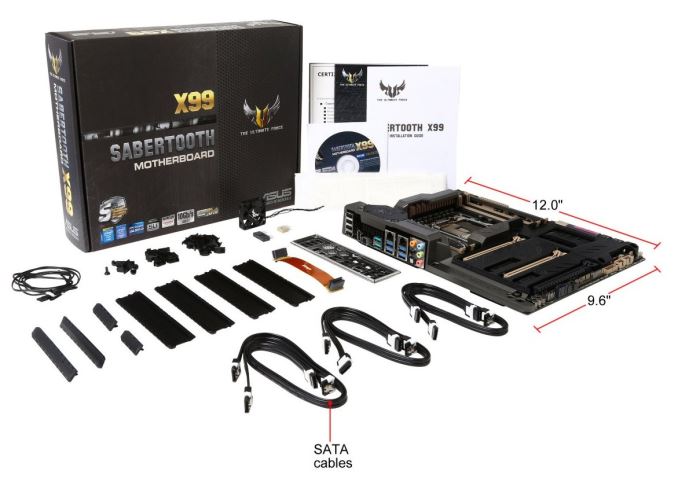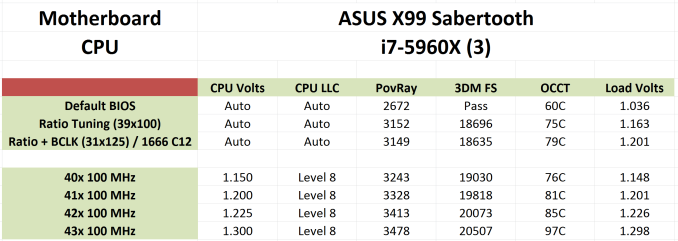The ASUS TUF X99 Sabertooth Review
by Ian Cutress on July 22, 2015 10:00 AM EST- Posted in
- Motherboards
- Asus
- TUF
- X99
ASUS TUF X99 Sabertooth In The Box
From the introduction page we’ve already pointed out that the Sabertooth comes with slot and port guards to protect against dust and sand, but the package also comes with the power delivery fan, three thermistors, six SATA cables, a Q-connector for the front panel header, a single flexi-SLI bridge, the rear IO shield, a driver disk and manuals
There wasn’t much else that ASUS could add to this box that would focus on the market this is intended for.
Many thanks to...
We must thank the following companies for kindly providing hardware for our test bed:
Thank you to AMD for providing us with the R9 290X 4GB GPUs.
Thank you to ASUS for providing us with GTX 980 Strix GPUs and the R7 240 DDR3 GPU.
Thank you to ASRock and ASUS for providing us with some IO testing kit.
Thank you to Cooler Master for providing us with Nepton 140XL CLCs.
Thank you to Corsair for providing us with an AX1200i PSU.
Thank you to Crucial for providing us with MX200 SSDs.
Thank you to G.Skill and Corsair for providing us with memory.
Thank you to MSI for providing us with the GTX 770 Lightning GPUs.
Thank you to OCZ for providing us with PSUs.
Thank you to Rosewill for providing us with PSUs and RK-9100 keyboards.
Test Setup
| Test Setup | |
| Processor | Intel Core i7-5960X ES 8 Cores, 16 Threads, 3.0 GHz (3.5 GHz Turbo) |
| Motherboards | ASUS TUF X99 Sabertooth |
| Cooling | Cooler Master Nepton 140XL |
| Power Supply | OCZ 1250W Gold ZX Series Corsair AX1200i Platinum PSU |
| Memory | Corsair DDR4-2133 C15 2x8 GB 1.2V or G.Skill Ripjaws 4 DDR4-2133 C15 2x8 GB 1.2V |
| Memory Settings | JEDEC @ 2133 |
| Video Cards | ASUS GTX 980 Strix 4GB MSI GTX 770 Lightning 2GB (1150/1202 Boost) ASUS R7 240 2GB |
| Hard Drive | Crucial MX200 1TB |
| Optical Drive | LG GH22NS50 |
| Case | Open Test Bed |
| Operating System | Windows 7 64-bit SP1 |
ASUS TUF X99 Sabertooth Overclocking
Experience with ASUS TUF X99 Sabertooth
The X99 Sabertooth sits between a rock and hard place when it comes to overclocking. X99 is a chipset which enables overclocking, and almost every motherboard for the platform is built to handle it. By virtue of the upgraded components leading to the 5-year warranty on the Sabertooth, one could argue that it already fulfills the requirement for being built towards holding an overclock. Nevertheless, the software does not outwardly promote overclocking, instead focusing on longevity. For a proper overclock, the BIOS has two auto-overclock options (CPU Level Up) or the full range of manual overclock settings.
Methodology
Our standard overclocking methodology is as follows. We select the automatic overclock options and test for stability with PovRay and OCCT to simulate high-end workloads. These stability tests aim to catch any immediate causes for memory or CPU errors.
For manual overclocks, based on the information gathered from previous testing, starts off at a nominal voltage and CPU multiplier, and the multiplier is increased until the stability tests are failed. The CPU voltage is increased gradually until the stability tests are passed, and the process repeated until the motherboard reduces the multiplier automatically (due to safety protocol) or the CPU temperature reaches a stupidly high level (100ºC+). Our test bed is not in a case, which should push overclocks higher with fresher (cooler) air.
Overclock Results
Both of the automatic overclocks did well, scoring under 80C at load although arguably 3.9 GHz isn’t much to shout about. The fact that the second CPU Level Up option put the memory at DDR4-1666 C12 was a little odd as well. For manual overclocks, we were restricted by our bad CPU sample, but 4.3 GHz came easily enough before hitting 100C+ during an AVX load.












57 Comments
View All Comments
sonny73n - Thursday, July 23, 2015 - link
Purely aesthetic. It's not good for heat dissipation and it can't block fine dust either.s0urce - Thursday, July 23, 2015 - link
The board includes a fan to move air underneath the armor, not needed but as an option.Gigaplex - Wednesday, July 22, 2015 - link
"In this orientation, the drive can be booted from, but the OS has to be installed via a UEFI install. This means there has to be the appropriate boot profile in the OS, which most modern versions of Windows have (though my Windows 7 SP1 install did not)."Can you elaborate? Windows 7 supports UEFI. What specifically is Windows 7 lacking that prevented it from working?
evilspoons - Wednesday, July 22, 2015 - link
I think you have to install Windows 7 in UEFI or in "traditional" mode, it can't switch back and forth. They probably have some sort of base image they're working off of with all their test tools and that test image goes to MBR/BIOS/whatever it's called mode.I had that kind of problem with my Z868-V PRO, it can technically boot Win7 in UEFI or BIOS mode, but it doesn't provide a nice way to specify which and the Win7 installer gets confused. This lead to me being unable to use a full-disc image backup created by Win7.
Gigaplex - Thursday, July 23, 2015 - link
I guess that depends on how it is imaged. The standard Windows installer uses a WIM image and that can install the image as either BIOS or UEFI depending on which bootloader was used. If they're using the Windows AIK to build and apply the image I'd expect it to work in the same way.althaz - Wednesday, July 22, 2015 - link
Why do so few motherboard manufacturers care about POST times. I'm nearly ready for an upgrade. My PC currently posts then loads windows in ~6 seconds (Windows 8.1, haven't tested it since switching to Win 10). If it blows out to 10 seconds...I guess I could deal with that. Any longer and I am *not* interested.For those that care I have an Intel board with quick-boot enabled and Asus' XXX-Deluxe motherboards are also usually quick as hell (but have to be configured to POST quickly, out of the box they are sloooowwww).
Gigaplex - Thursday, July 23, 2015 - link
Quite a few care, and Asus is one of them. The problem is that lots of extra controllers plus the X99 platform itself doesn't lend well to low POST times.DanNeely - Thursday, July 23, 2015 - link
X99 boards are also hindered in that they have more hardware (28/40 PCIe lanes vs 16, 4 dram controllers vs 2) that needs initialized at startup.khanikun - Thursday, July 23, 2015 - link
Probably cause no one really cares all that much. Most enthusiasts probably only reboot once a month, if not longer between gaps.I had a machine that took over 2 minutes to even start attempting to boot Windows. It had to go through 3 raid controllers and had staggered hdd spin up.
gammaray - Friday, July 24, 2015 - link
i got an i7 4770k with a Z87 mobo, why would i need a x99 board? i still don't get it.